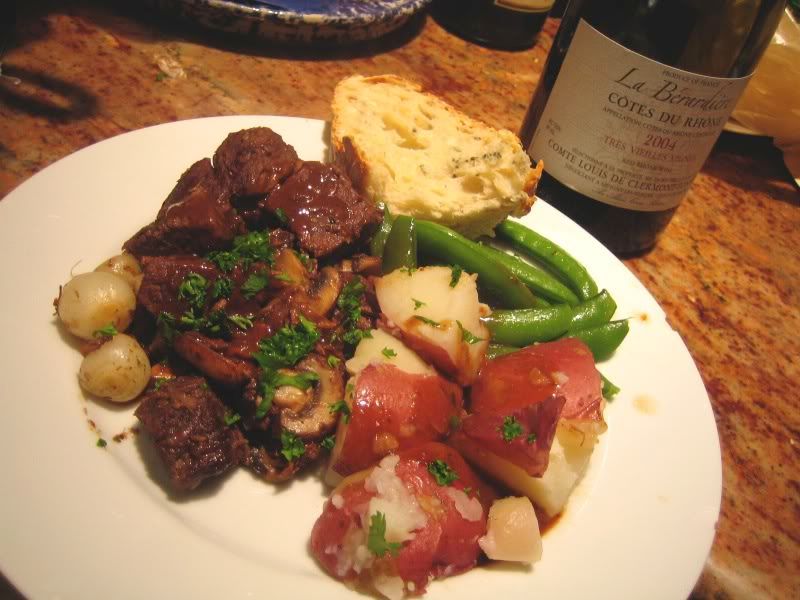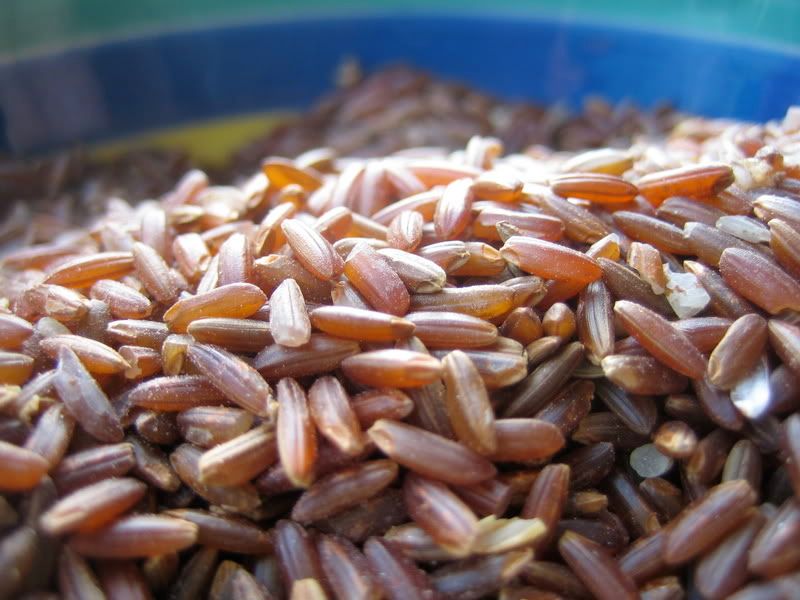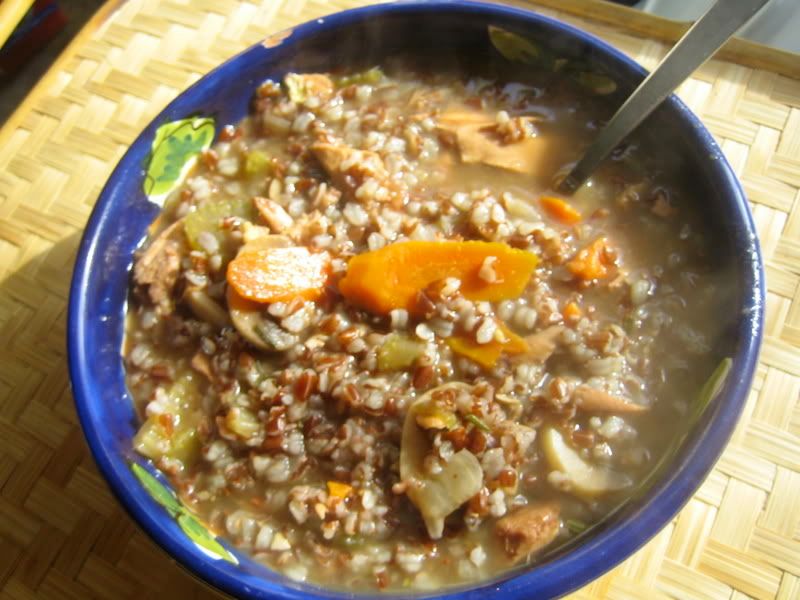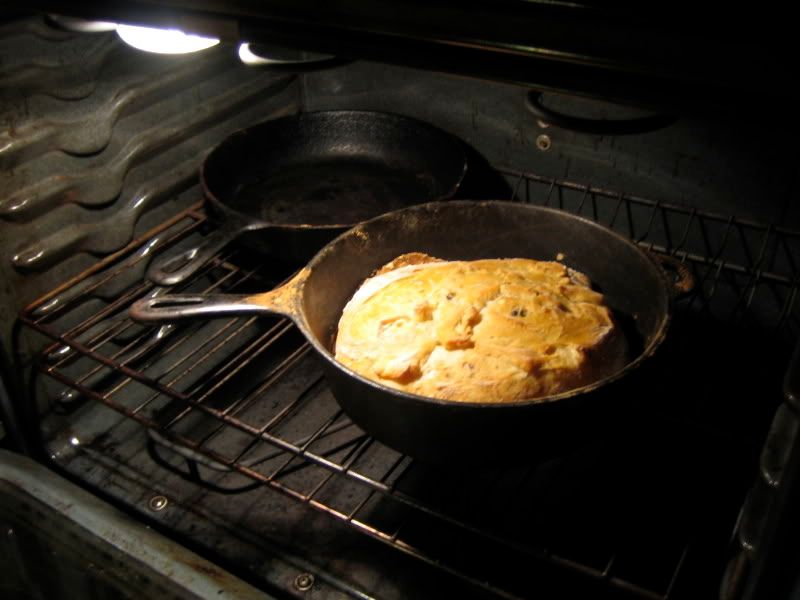11.28.2006
Red Rice and Roast Chicken Soup - Recipe
How fortunate that I've become ill. You see, a couple days ago I roasted a chicken--the typical fare: garlic and rosemary inserted under the skin in several places and basted in its own juices along with some chicken stock--and had quite a bit leftover. If not for the fact that I seem to be coming down with a chest cold, I probably would not have stumbled on the idea of making this delicious soup, when I should have instead been studying for my Criminal Procedure and Evidence exams.
I have had a bag of Himalayan red rice in my cupboard for far too long (I bought it at a farmer's market in Sarasota) waiting for some enticing recipe to come along. My patience finally worn thin, I used it today in my own variation of the old standard: chicken soup.
Himalayan red rice is similar in texture and flavor to brown rice, and may even taste a bit nuttier. The rice you see above is uncooked. Once cooked, it opens up much like brown rice, which could serve just as well in this soup. There are other ingredients which could be substituted with the ones below. I just used what I had on hand.
Calvados is a French apple brandy with an alcohol content of about 40 proof. The kind I had in the cupboard was made strictly for cooking. I should have heeded the label's warning: "seulement pour les alimentaires." I tried a small shot and spat it out immediately (in a fine spray, for comedic value). It was flavored with pepper and a little bit of salt.
If it didn't make for a good apertif, it did add a great flavor to the soup. However, since some people don't have a bottle of calvados sitting around, I have to say that white wine or sherry would probably work just as well. Also, normally I probably would have used all chicken stock, but I had some beef stock left over from last week's bourguignon. It added a nice, extra richness to the soup.
Now if you'll pardon me, Kitchen Monkey needs to take an Emergen-C and a nap.
Red Rice and Roast Chicken Soup
Serves 6 - Cooking time approx. 2 hours. Prep time approx. 45 minutes.
1/2 roast chicken - shredded or chopped (I used the breasts for other meals, putting one on a salad, and used the thighs and drumsticks for this soup).
1 cup red (or wild brown) rice
4 cups chicken stock
1 cup beef stock
1/2 cup Calvados (or white wine or sherry)
1 sprig fresh rosemary - minced
small handful chives - chopped (you might use thyme instead)
2 bay leaves
4 medium-sized carrots - sliced
1 large onion - chopped
3 celery stalks - chopped
3 cloves garlic - minced
1/2 lb. mushrooms - oyster, porcini, crimini, or even just good old fashioned white
3 allspice berries
salt and pepper to taste
(1) Shred the chicken and set aside
(2) Combine stock and calvados in a large pot over medium-high heat.
(3) Wash rice repeatedly then add to the pot.
(4) In a large sautee pan, sautee the carrots, onion, and celery in olive oil for about 10 minutes, adding the garlic toward the end
(5) Once the pot is boiling, turn the heat down to low, and add the vegetables, the mushrooms, the herbs, and the chicken, along with some salt and pepper.
(6) keep at a simmer for at least an hour, preferably longer. Add salt and pepper to taste, eat with some good crusty bread, and start feeling better as soon as possible.
Incidentally, the picture below demonstrates that I used much more rice than the recipe above indicates. I wanted to use all the red rice I had on hand, but next time I would use less.
11.26.2006
A North Carolina Thanksgiving Hootenanny
Every Thanksgiving I try to talk my friends and/or family into stuffing ourselves with something different than the same tired turkey, mashed potatoes and overcooked green bean casserole. Why, when we could spend half the day chatting around the table while we make shredded pork tamales while a molé sauce slowly simmers in the kitchen? Why, when we could have a fine spread of mezze and a nice big roast leg of lamb?
Sometimes I'm too quick to subvert the tried-and-true of tradition to the new and the unique. This might be a problem if I decide to marry and have children. Heaven help that woman, if she is hoping to bestow her young with names that have been in the family for generations--or just good solid names like "Elizabeth," "David," and "Robert"--for I intend to name my children after various cheeses of the world. My daughter would undoubtedly be named Brie. Sure, gradeschool might be a tough experience for little Munster, but he'll have his older brothers to understand and help protect him, since they will have had plenty of experiences to toughen up under the names Drunken Goat and Stinking Bishop. And who can forget little Baby Swiss, who will go by her middle name Gruyere, once she's old enough.
In any case I inevitably lose out over the Thanksgiving meal planning and this is probably a good thing. This year's turkey was fantastic, as was the rest of the meal. But let's proceed chronologically, shall we?
One of my sisters has lived in Asheville, North Carolina for the past year and a half. I finally made it down there, for Thanksgiving weekend, and quickly fell in love with the surrounding countryside and the local barbecue. When we arrived late in the evening my sister had generously prepared for us a large pot of Italian-style spicy mussels as well as some outrighteously good hors d'oeuvres: mushroom caps stuffed with bacon, cream cheese, and figs, served with a balsamic vinniagrette reduction. If she's not careful she's going to surpass her older brother as the chef de la famille. I wish she lived closer, in part so that I could more frequently benefit from such a potential rivalry.
We had Thanksgiving dinner on Friday, since it took us all day to drive to Asheville from D.C. There were about ten of us, and everybody helped out in some way. The next-door neighbor, a wine distributor, brought a delicious carrot soup, a bottle of fantastic red wine, and two bottles of expensive champagne. As much as we liked them, our pallettes were probably too unrefined to really appreciate it. I made a couple loaves of bread (see recent post) that turned out a bit denser than before, since I had only regular and not instant yeast on hand. I also made an apple and raisin galette that turned out alright, but tasted quite good the next day. There was much drinking and rejoicing, and dinner was followed by a passing around of the guitar.
The following day we did our best to walk off our prominent bellies by hiking through the Blue Ridge Mountains. I'm not sure how far we hiked, but if the soreness of my legs is any guide, I would say probably about 375 miles. Our chosen endpoint was the waterfall you see in the photograph above. There was much rejoicing. Jean-Jacques, my soon-to-be brother-in-law dunked his head in the freezing water to demonstrate his manliness, or insanity, or both, after which he yelped loudly "my BRAIN is FROZEN!!" (It sounds better with his Senegalese accent).
After the hike we were ravenous. Fortunately one of my sister's friends treated us all to an enormous meal of North Carolina BBQ (which tends to be tangy due to a larger ratio of vinegar to other ingredients) mac n'cheese, coleslaw, and potato salad. He picked the 'cue up from Ed Boudreaux's Bayou BBQ. It was fantastic, and if you're ever in Asheville I highly recommend it.
So it was a lovely vacation. I'm now retreating reluctantly into the ascetic shadowland of studying for law school finals, so there may not be too many posts in store until after December 9th. Expect a deluge at that point. I'm going to try and make everything between then and the New Year.
And for Christmas dinner I'm going to try and talk the family into a nice big sushi platter.
11.19.2006
Boeuf Bourguignon

Last Christmas a friend gave me a copy of Jacques Pépin's memoir, The Apprentice: My Life in the Kitchen. It was a nice gift, but I didn't feel compelled to read it right away. I was in my first year of law school, and I knew little about Jacques Pépin except that he was a culinary bosom buddy of Julia Child's. I finally picked the book up last weekend in an effort to rest my brain from the infernal madness of the Federal Rules of Evidence.
It is really quite a read. The writing is good for a memoir--simple and direct--but more importantly his enormous enthusiasm for the culinary arts comes through on every page. He had an inspiring life, from a poor provincial upbringing to cooking for Charles deGaulle at a young age, followed by world reknown through his association with Julia Childs. By page 5 it had me drooling and achingly reminiscing about my stay in Paris and Montpellier a little over a year ago (ahhhh remembering wild boar saucissions and canard au miel).
At the end of every chapter is a recipe, none of which I've yet tried, but I intend to (and will certainly post about it when I do). In short, I recommend it to anyone who is either a francophile or crazy about inedible food.
Sorry, I meant "incredible" food.
I had been meaning to make Boeuf (pronounced behhhffff, as though a sock to the stomach just caught you by surprise) Bourguignon for some time now, but reading the memoir finally inspired me enough to do it. I adapted it from a few different recipes (including Julia Child's recipe from Mastering the Art of French Cooking), all of which shared the same basic elements.
Thanks to Tyler and Lily for being my guinea pigs. I'd rather cook for them than Charles deGaulle any day.
Boeuf Bourguignon
(this loose recipe serves about 6 people)
6 strips thick cut bacon
3 lbs. stew beef
1/2 large onion
2-3 Tbsp flour
3 cups hearty red wine (I used a Chianti)
1 cup beef stock
1 bay leaf
1 tablespoon fresh thyme
salt and pepper
pearl onions, peeled (easiest if you boil them with skins on for 2 minutes, then dunk in cold water, chop off the stem portion, then squeeze the onion out of its peel)
crimini mushrooms
(1) boil thick cut bacon for 10 minutes, then fry bacon in a large sautee or casserole
(2) remove bacon, and sear about 3 lbs. of cubes of stew beef, remove from pan and combine with bacon, after which you'll want to preheat the oven to 325 degrees
(3) brown sliced onions in the remaining fat
(4) return bacon and beef cubes to the pan or pot, add the two or three tablespoons of flour to the pot and stir to make sure the beef is coated
(5) place in the oven for 4-7 minutes, remove, stir, and return for another 4-7 minutes
(6) remove pan to the range on high heat, then add 3 cups or so of wine until boiling
(5) add beef stock, continue to boil, add crumbled bay leaf, thyme, and salt and pepper
(6) turn down to a simmer, then remove the pan to the middle rack of the oven
(7) allow to simmer in the oven for 2-3 hours
(8) about 15 minutes before removing the ingredients, sautee the pearl onions and mushrooms in a bit of olive oil and or butter until just barely soft.
(9) remove pan, and strain the liquid into a saucepan. Set the meat aside while the sauce reduces on high heat (thick, but not too thick!) Just before it is done reducing, heat up the beef , bacon, etc. along with the pearl onions and mushrooms until sizzling just a bit.
(10) serve up the beef, etc. and ladle a good bit of sauce over it.
I served it with green peas braised in chicken broth and boiled red potatoes tossed in a bit of butter and some parsely. The bourguignon sauce also tastes fantastic on the potatoes.
Yes, it requires some work. But make enough for leftovers (it tastes even better the next day) and you'll thank yourself.
It is really quite a read. The writing is good for a memoir--simple and direct--but more importantly his enormous enthusiasm for the culinary arts comes through on every page. He had an inspiring life, from a poor provincial upbringing to cooking for Charles deGaulle at a young age, followed by world reknown through his association with Julia Childs. By page 5 it had me drooling and achingly reminiscing about my stay in Paris and Montpellier a little over a year ago (ahhhh remembering wild boar saucissions and canard au miel).
At the end of every chapter is a recipe, none of which I've yet tried, but I intend to (and will certainly post about it when I do). In short, I recommend it to anyone who is either a francophile or crazy about inedible food.
Sorry, I meant "incredible" food.
I had been meaning to make Boeuf (pronounced behhhffff, as though a sock to the stomach just caught you by surprise) Bourguignon for some time now, but reading the memoir finally inspired me enough to do it. I adapted it from a few different recipes (including Julia Child's recipe from Mastering the Art of French Cooking), all of which shared the same basic elements.
Thanks to Tyler and Lily for being my guinea pigs. I'd rather cook for them than Charles deGaulle any day.
Boeuf Bourguignon
(this loose recipe serves about 6 people)
6 strips thick cut bacon
3 lbs. stew beef
1/2 large onion
2-3 Tbsp flour
3 cups hearty red wine (I used a Chianti)
1 cup beef stock
1 bay leaf
1 tablespoon fresh thyme
salt and pepper
pearl onions, peeled (easiest if you boil them with skins on for 2 minutes, then dunk in cold water, chop off the stem portion, then squeeze the onion out of its peel)
crimini mushrooms
(1) boil thick cut bacon for 10 minutes, then fry bacon in a large sautee or casserole
(2) remove bacon, and sear about 3 lbs. of cubes of stew beef, remove from pan and combine with bacon, after which you'll want to preheat the oven to 325 degrees
(3) brown sliced onions in the remaining fat
(4) return bacon and beef cubes to the pan or pot, add the two or three tablespoons of flour to the pot and stir to make sure the beef is coated
(5) place in the oven for 4-7 minutes, remove, stir, and return for another 4-7 minutes
(6) remove pan to the range on high heat, then add 3 cups or so of wine until boiling
(5) add beef stock, continue to boil, add crumbled bay leaf, thyme, and salt and pepper
(6) turn down to a simmer, then remove the pan to the middle rack of the oven
(7) allow to simmer in the oven for 2-3 hours
(8) about 15 minutes before removing the ingredients, sautee the pearl onions and mushrooms in a bit of olive oil and or butter until just barely soft.
(9) remove pan, and strain the liquid into a saucepan. Set the meat aside while the sauce reduces on high heat (thick, but not too thick!) Just before it is done reducing, heat up the beef , bacon, etc. along with the pearl onions and mushrooms until sizzling just a bit.
(10) serve up the beef, etc. and ladle a good bit of sauce over it.
I served it with green peas braised in chicken broth and boiled red potatoes tossed in a bit of butter and some parsely. The bourguignon sauce also tastes fantastic on the potatoes.
Yes, it requires some work. But make enough for leftovers (it tastes even better the next day) and you'll thank yourself.
11.14.2006
America Ready for Change: A Bread Revolution
On November 7, 2006, Americans sent a clear message: "we are ready for a change." No longer would we tolerate the shoddy results of conflicting and outdated ideas. We wanted a new bread recipe. Yes, on the day and the day after a historic election, the number one most read and e-mailed article in the New York Times was not a narrative of a shift in Congress from the party of the corrupt and incompetent to the party of the hapless and eventually corrupt.
It was, rather, Mark Bittman's column as "The Minimalist" describing an amazing new method of making bread. The recipe is at the bottom of this post, maybe in flagrant violation of copyright laws. But hey, I haven't taken Intellectual Property Law yet, not until next fall, so who knows? Heh heh. Thousands upon thousands of Americans spent this past weekend making this bread, and its rewards are unmistakable. The secret is a long initial rising period (12-20 hours), followed by a 2-hour rising period, followed by baking inside a pre-heated, covered, piping hot dutch oven. The article suggested use of a Le Creuset type receptacle. Unfortunately, my budget has yet to afford me such a beautiful piece of cookware, so I made do with two large, deep cast iron griddles, and it worked beautifully.
After my initial attempt turned out well I made FOUR loaves the following day. Two of them were made with diced fresh rosemary, the other two with fresh basil and diced calamata olives. They were perfect. Crisp crust, soft but chewy inside. So good that I came home the next day to find out that my roommates had eaten an entire loaf! Guess I'll have to make more next weekend.
Oh, and sorry I haven't posted in a couple weeks. You know, the whole law school thing. A beintot mes singes.
Adapted from Jim Lahey, Sullivan Street Bakery Time: About 1½ hours plus 14 to 20 hours’ rising
3 cups all-purpose or bread flour, more for dusting ¼ teaspoon instant yeast (rapid rise yeast)
1¼ teaspoons salt
Cornmeal, wheat bran, or more flour as needed.
1. In a large bowl combine flour, yeast and salt. Add 1 5/8 cups water, and stir until blended; dough will be shaggy and sticky. Cover bowl with plastic wrap. Let dough rest at least 12 hours, preferably about 18, at warm room temperature, about 70 degrees.
2. Dough is ready when its surface is dotted with bubbles. Lightly flour a work surface and place dough on it; sprinkle it with a little more flour and fold it over on itself once or twice. Cover loosely with plastic wrap and let rest about 15 minutes.
3. Using just enough flour to keep dough from sticking to work surface or to your fingers, gently and quickly shape dough into a ball. Generously coat a cotton towel (not terry cloth) with flour, wheat bran or cornmeal; put dough seam side down on towel and dust with more flour, bran or cornmeal. Cover with another cotton towel and let rise for about 2 hours. When it is ready, dough will be more than double in size and will not readily spring back when poked with a finger.
4. At least a half-hour before dough is ready, heat oven to 450 degrees. Put a 6- to 8-quart heavy covered pot (cast iron, enamel, Pyrex or ceramic) in oven as it heats. When dough is ready, carefully remove pot from oven. Slide your hand under towel and turn dough over into pot, seam side up; it may look like a mess, but that is O.K. Shake pan once or twice if dough is unevenly distributed; it will straighten out as it bakes. Cover with lid and bake 30 minutes, then remove lid and bake another 15 to 30 minutes, until loaf is beautifully browned. Cool on a rack.
Yield: One 1½-pound loaf.
Subscribe to:
Posts (Atom)





